
One final cool spell for RVA, then warmer for the weekend and beyond
Richmond has reached the time of year when the normal high temperature has crossed the 70-degree threshold — a benchmark that we will stay above until the middle of October. For the next couple of days we will be below that benchmark, but warm weather will dominate for the rest of the month.
In the short term, sunny and cool weather holds for both Wednesday and Thursday, as afternoons remain in the 60s, and we will have the season’s final legitimately cold night on Wednesday night. Temperatures will edge into the 30s by dawn on Thursday morning, and there may be some spotty frost in open fields and away from urban areas, but it will not be cold enough for a freeze.
Friday returns to the 70s, then Saturday soars into the 80s.
A couple of weak systems will come through early Friday morning and again on Monday morning, but neither one looks strong enough to produce more than a few small showers. With that in mind, the next chance of a soaking rain waits until the second half of next week.
That Monday system will signal a small retreat in temperatures closer to normal, but truly cold air — something that keeps a sunny afternoon in the 50s — appears locked away until next fall.
Beyond the end of next week, the weather pattern favors temperatures near or above normal for the final few days of the month.
There is one final caution, as some data indicate a cool spell during the first full week of May. But even that does not suggest a frost or a freeze.
First of the Hurricane Outlooks
Earlier this month, the World Meteorological Organization retired Beryl, Helene, and Milton from one of their six rotating lists of Atlantic hurricane names, as those three storms were particularly devastating. Helene was the 7th costliest (adjusted for inflation) storm on record in the United States, and Milton was the 5th-strongest on record (measured by central pressure).
This year, another busy season is anticipated, but expectations are not as worrisome as last year at this time.
In terms of hurricane fuel, water temperatures in the Atlantic Ocean are warmer than normal, just not to the extent of last year. Regarding formation of hurricanes, the major player is the phase of the El Niño phenomenon, which corresponds to how conductive the winds are in the middle and upper atmosphere for hurricane development. After several months in the La Niña phase, which is more conducive for development, it has recently moved to a neutral phase.
The predictability of that phase several months in advance has some skill, but it is far from a lock. Nonetheless, most indications are that it will either remain neutral or go back to La Niña, reducing the chances of getting a season that is less active than normal.
The tropical weather professionals at Colorado State University, who pioneered these outlooks more than 40 years ago, expect a season that is near or more active than normal.
On average, 14 tropical systems became strong enough to get names, with half of those going on to become hurricanes. CSU expects 17 named storms this year, with 9 becoming hurricanes.
These are numbers for the entire Atlantic basin, which includes the Caribbean Sea, Gulf of Mexico, and the Atlantic Ocean. They do not tell us anything about where a hurricane will specifically strike, only how active the season will be across the basin.
But of course, more storms means more risk.
Last year, CSU forecast an especially active season — 23 named storms and 11 hurricanes. The total number of named storms was 18, but 11 of those became hurricanes.
This is consistent with what we understand about hurricanes and the warming climate. The total number of these tropical systems is not expected to increase dramatically, but the ones that do form will tend to be stronger.
Hurricane season begins June 1.
NOAA Cuts Loom Large
Whether we like it or not, the political situation is coming for the weather business. According to E&E News, who are among the numerous outlets that obtained the NOAA budget memo from current and former NOAA employees, funding will be slashed by 25 percent.
Among the impacts are the effective scuttling of the next generation of weather satellites (GeoXO) and the elimination of programs designed to conserve, protect, and restore marine habitats.
Funding for the NOAA regional climate centers would also be eliminated, which currently provide region-specific data to the parts of the country they serve. After all, the climate of Arizona is very different from that of Massachusetts.
This budget is reflective of the infamous Project 2025, which sets out to dismantle NOAA and end its research on the warming climate and how it will impact Americans.
Alan Gerard, a meteorologist who recently retired from NOAA after 35 years, wrote this week in his Balanced Weather newsletter, “Given the immense benefits I have witnessed them provide over the decades, it is inconceivable to me that we would intentionally destroy the incredible infrastructure of national laboratories and cooperative institutes that has been built by NOAA over the decades.”
NOAA — the parent organization of the National Weather Service — provides the environmental intelligence we all use to protect our air and water while also helping manage those natural resources. These cuts would set the science of weather forecasting back 40 or 50 years, making environmental planning from agriculture to coastal infrastructure more difficult, and thinking more locally, could increase water pollution from the James River to the Chesapeake Bay.






